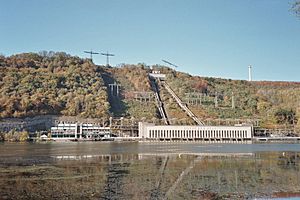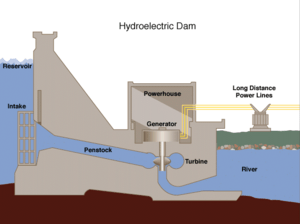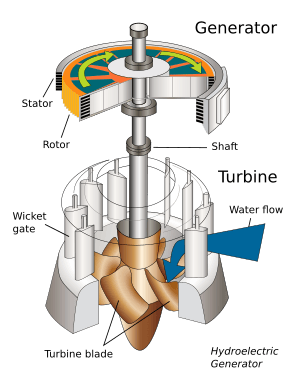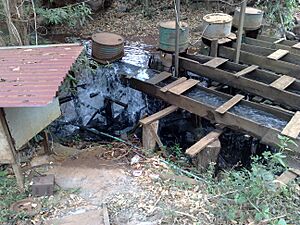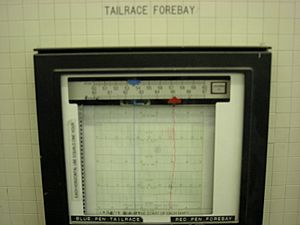Hydroelectricity facts for kids
Hydroelectricity is a way to make electricity using the power of moving water. It's a type of renewable energy, which means it comes from a source that won't run out, like the sun or wind. Most of the time, hydroelectricity is made using a large wall called a dam. This dam blocks a river and creates a big lake behind it, called a reservoir.
When the water is let go from the reservoir, it rushes down large pipes. This rushing water spins a special machine called a turbine. The turbine is connected to an electrical generator, which then creates electricity. This method makes less pollution than burning fossil fuels like coal or oil. Some countries and regions, like Norway and Quebec in Canada, get most of their electricity this way.
Contents
How Hydroelectric Power Plants Work


Hydroelectric power plants use different ways to turn water's movement into electricity. The main idea is always to use the force of water to spin a turbine.
Dams and Water Power
Most hydroelectric power comes from water held back by a dam. The water in the reservoir has a lot of stored-up energy because of its height. This is called potential energy. When the water is released, it flows down a large pipe called a "penstock." The difference in height between the water in the reservoir and where it exits is called the "head." The higher the head and the more water that flows, the more power can be made. The rushing water spins a water turbine, which then powers an electrical generator to make electricity.
Pumped-Storage Hydroelectricity
This method helps power plants deal with changing electricity needs. When there's not much demand for electricity, like at night, extra power is used to pump water from a lower reservoir to a higher one. This stores energy. When many people need electricity, like during the day, the water is released from the higher reservoir. It flows down through turbines to the lower reservoir, making electricity. This system helps keep the power grid stable.
Run-of-the-River Systems
Some hydroelectric stations don't use large dams or reservoirs. These are called "run-of-the-river" systems. They use the natural flow of a river to generate electricity. They don't store much water, so they can only make electricity from the water that is flowing at that moment. If there's too much water, the extra flow might go unused. These systems work best on rivers with a steady water supply.
Tidal Power
Tidal power stations use the natural rise and fall of ocean tides to make electricity. The tides are very predictable, which is a big advantage. If conditions are right, these stations can build reservoirs to store water. This allows them to release water and generate power when electricity is needed most. Tidal power is only possible in certain places around the world where the tides are strong enough.
Types of Hydroelectric Facilities
Hydroelectric power plants come in many sizes, from huge facilities that power cities to tiny ones that light up a few homes.
Large Hydroelectric Plants
Large hydroelectric power stations are some of the biggest power producers in the world. Some of these plants can make more than twice the electricity of the largest nuclear power stations. While there's no exact rule for what counts as "large," facilities that produce more than a few hundred megawatts (MW) are usually considered large.
Here are some of the biggest hydroelectric plants in the world:
| Rank | Station | Country | Location | Capacity (MW) |
|---|---|---|---|---|
| 1. | Three Gorges Dam | 30°49′15″N 111°00′08″E / 30.82083°N 111.00222°E | 22,500 | |
| 2. | Itaipu Dam | 25°24′31″S 54°35′21″W / 25.40861°S 54.58917°W | 14,000 | |
| 3. | Xiluodu Dam | 28°15′35″N 103°38′58″E / 28.25972°N 103.64944°E | 13,860 | |
| 4. | Guri Dam | 07°45′59″N 62°59′57″W / 7.76639°N 62.99917°W | 10,200 |
Small Hydroelectric Plants
Small hydro projects make electricity for a small community or a factory. The size of a small hydro project can vary, but it usually means a plant that produces up to 10 megawatts (MW) of power. In some places like Canada and the United States, this limit can be up to 25 or 30 MW. Small-scale hydroelectricity is growing around the world.

Small hydro plants can connect to the main power grid to provide clean energy. They can also be built in isolated areas where there is no national power network. Since these projects usually have smaller reservoirs and less construction, they often have less impact on the environment compared to very large dams.
Micro Hydroelectric Plants
Micro hydro installations are even smaller, typically producing up to 100 kilowatts (kW) of power. These systems can provide electricity to a single home or a small group of homes. They are very useful in developing countries because they offer an affordable way to get energy without needing to buy fuel. Micro hydro systems work well with solar power. In many areas, water flow is highest in winter when solar energy is lowest, so they complement each other.
Pico Hydroelectric Plants
Pico hydro is the smallest type of hydroelectric power, generating less than 5 kilowatts (kW). It's perfect for very small, remote communities that only need a little bit of electricity. For example, it can power a few light bulbs and a TV or radio for a few homes. These systems often don't use dams. Instead, pipes divert a small amount of water from a stream, let it drop down a slope, and then run it through a tiny turbine before returning the water to the stream.
Underground Power Stations
Sometimes, large hydroelectric plants are built underground. This is often done when there's a big natural height difference between two bodies of water, like a waterfall or a mountain lake. An underground tunnel carries water from the high reservoir to a power-generating hall built inside a cave deep underground. After passing through the turbines, the water flows out through another tunnel to a lower waterway.
Benefits of Hydroelectricity
Hydroelectricity has many advantages, especially for the environment.
- Clean Energy: Making electricity this way doesn't pollute the environment as much as burning fossil fuels like oil or coal. It produces no waste or harmful gases.
- Reliable and Safe: Hydroelectric power is very powerful and safe. Once a dam is built, the cost of making electricity is very low.
- Quick Power: Hydroelectric plants can start making electricity very quickly. This is helpful when people suddenly need a lot of power. Water stored in a reservoir can be released quickly to meet high demand.
- Supports Other Renewables: Because it can be turned on and off quickly, hydroelectricity works well with other energy sources like wind or solar. When the wind isn't blowing or the sun isn't shining, hydroelectric power can fill the gap.
- Renewable Resource: As long as there is a good supply of water, hydroelectricity will not run out. It's a sustainable energy source.
Challenges of Hydroelectricity
While hydroelectricity has many benefits, building large dams can also cause problems.
- Environmental Impact: Building large dams can change the environment significantly. For example, the Three Gorges Dam in China is the world's largest hydroelectric project. It flooded a huge area, which meant that 1.2 million people had to move from their homes.
- Habitat Changes: Flooding large areas can destroy natural habitats for plants and animals. It can also change the flow of rivers, affecting fish and other wildlife.
- Concerns about Safety: Scientists have raised concerns about large dams, including issues like pollution, silt buildup, and the safety of the dam structure itself.
Images for kids
-
The Three Gorges Dam in Central China is the world's largest power–producing facility of any kind.
-
Museum Hydroelectric power plant ″Under the Town″ in Serbia, built in 1900.
-
The Warwick Castle water-powered generator house, used for the generation of electricity for the castle from 1894 until 1940
-
The Ffestiniog Power Station can generate 360 MW of electricity within 60 seconds of the demand arising.
-
The Hoover Dam in the United States is a large conventional dammed-hydro facility, with an installed capacity of 2,080 MW.
-
Chemal hydroelectric power plant. Chemal (Altai), Russia.
-
Hydroelectric power plant in Glendo State Park, Wyoming, USA
-
Tagokura hydroelectric power plant, Tadami Town, Fukushima Pref., Japan.
See also
 In Spanish: Hidroelectricidad para niños
In Spanish: Hidroelectricidad para niños


